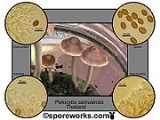
Psilocybe samuiensis
Encyclopedia
Psilocybe samuiensis is a psychedelic mushroom
, which has psilocybin
and psilocin
as main active compounds. It was placed in the Section Mexicanae of genus Psilocybe by Gastón Guzmán
due to its rhomboid-shaped spores. It has been found in Koh Samui, a small tropical island in Thailand
, where some psychoactive species are consumed by both natives and tourists.
is typically 7–15 mm in diameter, almost convex to conic in shape, umbonate with a small papilla
. The cap is viscid and has a separable pellicle
. It is a reddish-brown color when moist, but becomes lighter brown when dry. The stipe
is 4.0–6.5 cm high × 1.5 cm thick, equal or slightly bulbous. The stipe is hollow, whitish in color, and covered with white fibril
s. It is the same color as the cap, and stains blue when bruised.
The odor and taste are slightly like grain meal (farinaceous).
and TLC
, psilocybin
and psilocin
in the fruit bodies ranged from 0.023–0.90% (dry weight) and 0.05–0.81%, respectively. Baeocystin
was also detected at the concentration of 0.01–0.05%.
Psychedelic mushroom
Psilocybin mushrooms are fungi that contain the psychoactive compounds psilocybin and psilocin. There are multiple colloquial terms for psilocybin mushrooms, the most common being shrooms or magic mushrooms....
, which has psilocybin
Psilocybin
Psilocybin is a naturally occurring psychedelic prodrug, with mind-altering effects similar to those of LSD and mescaline, after it is converted to psilocin. The effects can include altered thinking processes, perceptual distortions, an altered sense of time, and spiritual experiences, as well as...
and psilocin
Psilocin
Psilocin , an aromatic compound, sometimes also spelled psilocine, psilocyn, or psilotsin, is a psychedelic mushroom alkaloid. It is found in most psychedelic mushrooms together with its phosphorylated counterpart psilocybin...
as main active compounds. It was placed in the Section Mexicanae of genus Psilocybe by Gastón Guzmán
Gastón Guzmán
Gastón Guzmán is a Mexican mycologist and anthropologist. He is considered the world's foremost authority on the genus Psilocybe.He was born in Xalapa, Veracruz, in 1932....
due to its rhomboid-shaped spores. It has been found in Koh Samui, a small tropical island in Thailand
Thailand
Thailand , officially the Kingdom of Thailand , formerly known as Siam , is a country located at the centre of the Indochina peninsula and Southeast Asia. It is bordered to the north by Burma and Laos, to the east by Laos and Cambodia, to the south by the Gulf of Thailand and Malaysia, and to the...
, where some psychoactive species are consumed by both natives and tourists.
Description
The capPileus (mycology)
The pileus is the technical name for the cap, or cap-like part, of a basidiocarp or ascocarp that supports a spore-bearing surface, the hymenium. The hymenium may consist of lamellae, tubes, or teeth, on the underside of the pileus...
is typically 7–15 mm in diameter, almost convex to conic in shape, umbonate with a small papilla
Papilla
The term papilla generally means a nipple-like structure, and may refer to:* Mammary papilla, or nipple* Amphibian papilla and basal papilla, part of the inner ear of the frog.* Interdental papilla, part of the gingiva between teeth...
. The cap is viscid and has a separable pellicle
Pellicle
Pellicle may refer to:*Pellicle , a thin layer supporting the cell membrane in various protozoa*Pellicle mirror, a thin plastic membrane which may be used as a beam splitter or protective cover in optical systems...
. It is a reddish-brown color when moist, but becomes lighter brown when dry. The stipe
Stipe (mycology)
thumb|150px|right|Diagram of a [[basidiomycete]] stipe with an [[annulus |annulus]] and [[volva |volva]]In mycology a stipe refers to the stem or stalk-like feature supporting the cap of a mushroom. Like all tissues of the mushroom other than the hymenium, the stipe is composed of sterile hyphal...
is 4.0–6.5 cm high × 1.5 cm thick, equal or slightly bulbous. The stipe is hollow, whitish in color, and covered with white fibril
Fibril
Fibril is a fine fiber approximately 1 nm in diameter.Cytoplasmic fibrils are observed on the protoplasmic cylinders found in most spirochetal species, although no function of the cytoplasmic fibrils has been ascribed....
s. It is the same color as the cap, and stains blue when bruised.
The odor and taste are slightly like grain meal (farinaceous).
Habitat
Psilocybe samuiensis was first picked in soil containing mixtures of sand and clay west of the village of Ban Hua Thanon, in Koh Samui. It grows scattered to gregarious in rice paddies, fruiting from early July to late August.Chemistry
Analysed by HPLCHigh-performance liquid chromatography
High-performance liquid chromatography , HPLC, is a chromatographic technique that can separate a mixture of compounds and is used in biochemistry and analytical chemistry to identify, quantify and purify the individual components of the mixture.HPLC typically utilizes different types of stationary...
and TLC
Thin layer chromatography
Thin layer chromatography is a chromatography technique used to separate mixtures. Thin layer chromatography is performed on a sheet of glass, plastic, or aluminum foil, which is coated with a thin layer of adsorbent material, usually silica gel, aluminium oxide, or cellulose...
, psilocybin
Psilocybin
Psilocybin is a naturally occurring psychedelic prodrug, with mind-altering effects similar to those of LSD and mescaline, after it is converted to psilocin. The effects can include altered thinking processes, perceptual distortions, an altered sense of time, and spiritual experiences, as well as...
and psilocin
Psilocin
Psilocin , an aromatic compound, sometimes also spelled psilocine, psilocyn, or psilotsin, is a psychedelic mushroom alkaloid. It is found in most psychedelic mushrooms together with its phosphorylated counterpart psilocybin...
in the fruit bodies ranged from 0.023–0.90% (dry weight) and 0.05–0.81%, respectively. Baeocystin
Baeocystin
Baeocystin is a mushroom alkaloid and analog of the psychedelic hallucinogenic drug psilocybin, a tryptamine derivative. It is found as a minor compound in most psychoactive mushrooms together with psilocybin, norbaeocystin, and psilocin...
was also detected at the concentration of 0.01–0.05%.

